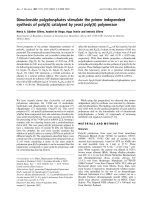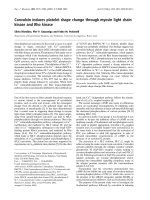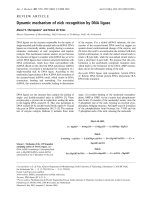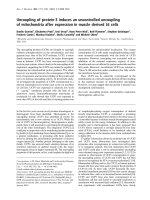Báo cáo y học: "Color blind" ppt
Bạn đang xem bản rút gọn của tài liệu. Xem và tải ngay bản đầy đủ của tài liệu tại đây (57.02 KB, 3 trang )
Genome Biology 2004, 5:119
comment
reviews
reports
deposited research
interactions
information
refereed research
Comment
Color blind
Gregory A Petsko
Address: Rosenstiel Basic Medical Sciences Research Center, Brandeis University, Waltham, MA 02454-9110, USA.
E-mail:
Published: 26 November 2004
Genome Biology 2004, 5:119
The electronic version of this article is the complete one and can be
found online at />© 2004 BioMed Central Ltd
By the time you read this, the result of the 2004 US Presi-
dential election will be known - assuming, of course, that
there isn’t a repeat of the travesty of 2000, when the
Supreme Court of the United States, by a vote that split
along the lines of which political party had appointed which
particular judge, awarded the election to George W. Bush by
the slimmest of margins (less than 1,000 votes) in the state
of which his brother was governor. Contested ballots
notwithstanding, I never cease to be amazed when I cast my
vote on election day. After the cacophony of the seemingly
endless campaign, on election day a curious quiet descends
on the country. No bands play. No troops march. People
waiting in line to vote tend to speak in hushed tones, almost
as though they were in church. I didn’t see a single cell
phone in use. The transfer of power in what is arguably the
most powerful nation in the history of the world happens
softly, like a whisper in the dark. That’s the wonder
of democracy.
Contrary to what many Americans think, democracy wasn’t
invented here. It has a long history, going back at least to
ancient Greece. And, especially if we have another disputed
election this time, I would have trouble arguing that it was
perfected here either. But if not the practice of democracy, I
think the concept of democracy may have reached its zenith
on these shores, in the city of Philadelphia, in the month of
June, in the year 1776. At that time and place, Thomas Jef-
ferson composed these words for the document in which the
thirteen former British colonies declared their indepen-
dence: “all men are created equal”. As a weapon in a war,
which it was, that phrase was powerful. It was meant to con-
vince and to confound, and it did both. Then it developed a
life of its own, and began to reverberate around the world
like the sound of an exploding volcano. It echoed in the
French Revolution thirteen years later. It could be heard in
1848, the year of revolutions in Europe. It was still echoing
more than a hundred years later when India broke from
Britain. It can still be heard today, as loud and potent as
ever. Not bad for an idea that is biological nonsense.
Basketball star Michael Jordan could jump through the roof
of a building; I never could. Footballer David Beckham can
bend a corner kick around a goalpost; I can barely kick a
soccer ball straight. I can’t run a marathon in under three
hours and I never would be able to no matter how hard and
long I trained. Neither could most people, nor do they
expect to. Implicit in the meritocracy of sport is the idea
that, although practice and coaching are important, there
are vast differences in talent among individuals. Such limi-
tations are understood in other areas as well: most people
cannot do high-level mathematics and probably never could
no matter how long they studied. I took piano lessons for
five years, but Horowitz is a pianist; I’m not, and never will
be. We all know these things, and accept them. But taken lit-
erally, “all men are created equal” could imply that such
facts aren’t true. Of course, the phrase was never meant to
refer to physical abilities, or talent for music or abstract rea-
soning. It meant that all men (alas, the Founding Fathers
probably really did mean only men - there were no Found-
ing Mothers to set them straight) should be equal in the eyes
of the law, and the government. Since I live in a country
where the wealthy and influential often receive preferential
treatment by both, I understand that this is an ideal not
always achieved in practice.
But the extreme interpretation is always there, in any
democracy. It’s responsible for the contempt of ‘the elite’ or
‘intellectuals’ that one hears, especially around election time.
It underlies our iconoclastic tendencies. Somewhere, in
some inner place that is hard to reach, a lot of us harbor the
secret belief that we’re just as good as anybody, in just about
everything. Maybe this delusion is harmless, but I doubt it. I
think it contributes to the streak of anti-intellectualism that
has a foothold in Western culture right now. I think it also
makes it easier for populists and demagogues to coax people
into voting against their self-interests. But even if I’m wrong
about these consequences, there is one area in which the
notion of absolute equality is certainly dangerous: the area
of medicine.
This month, a report appeared in The New England Journal
of Medicine (351:2049-2055; issue of 11 November 2004)
entitled “Combination of Isosorbide Dinitrate and
Hydralazine in Blacks with Heart Failure”. The article was
written by Anne L. Taylor MD, Susan Ziesche RN, and a
number of other authors, on behalf of the African-American
Heart Failure Trial Investigators. The paper presents the
results of a study of 1,050 black patients with advanced heart
failure. Half received a placebo, while the other half received
BiDil, a combination of two generic drugs (isosorbide dini-
trate, which stimulates the production of nitric oxide, and
hydralazine, an antioxidant and vasodilator that appears to
prevent the nitric oxide from deactivating). The results were
so striking that the study was terminated prematurely so
that all remaining patients could be given BiDil. Over the
two years of the study, 6.2% of the patients given the drug
died, compared with 10.2% of those given the standard treat-
ment, a 43% improvement. First hospitalizations were also
reduced by 33%. Ray Gibbons, a cardiologist at the Mayo
Clinic and spokesman for the American Heart Association,
says “When you have this level of risk reduction in a high-
stakes disease like heart failure, it’s at least a home run.” The
study was initiated by NitroMed, Inc., a biotechnology
company in Lexington, Massachusetts. Combined use of the
two generic drugs would allow NitroMed to receive a new
patent for the joint formulation. An earlier trial of the
mixture, by Dr Jay Cohn of the University of Minnesota in
the 1980s, had been disappointing: in a test against the
general population, the drugs fared worse than angiotensin-
converting enzyme (ACE) inhibitors. But Dr Cohn reana-
lyzed the data when it became clear years later that one
reason African-Americans die from heart failure at 2.5 times
the rate of Caucasians was because ACE inhibitors appear to
be much less effective in black patients than in non-blacks.
Sure enough, in the 395 black patients in the original study,
the drug combination appeared better than the standard
therapy. The new trial, exclusively in African-Americans,
was begun as a consequence.
So why isn’t everybody cheering? Many are, including the
Association of Black Cardiologists, who cosponsored the
trial. But others are not. In a perspective in the same issue of
The New England Journal of Medicine, Dr M Gregg Bloche
of Georgetown University Law Center asks, “Are we moving
into a new era of race-based therapeutics?” He believes the
answer is yes, especially since the US Food and Drug Admin-
istration has already indicated that if the drug is approved, it
will be labeled as indicated for patients of African-American
descent, an unprecedented situation. (Although at least 29
drugs are known to have different efficacies between blacks
and Caucasians, none of them is labeled in this way.)
JudyAnn Bigby, director of the Office for Women, Family
and Community Programs at Brigham and Women’s Hospi-
tal in Boston, fears that “if people get one little inkling that
there’s a biological basis to race, we could potentially lose
ground in understanding racial differences in disease.
Biology could be an excuse for not looking at the social
basis” of diseases like heart disease, which is known to be
affected by stress, income, diet and access to health care,
among other non-genetic factors. “You have the federal gov-
ernment giving its imprimatur, its stamp of approval, to
using race as a biological category,” warns Jonathan Kahn,
of Hamline University, who wrote a paper in the Yale
Journal of Health Policy, Law, and Ethics on the danger of
approving BiDil. “To my mind, it’s the road to hell being
paved with good intentions.”
This concern is understandable given the sorry history of the
US when it comes to matters of race. Yet we have known for
half a century that sickle-cell anemia is overwhelmingly a
disease of blacks, that Tay-Sachs Disease is overwhelmingly
a disease of Ashkenazi Jews, and that cystic fibrosis is over-
whelmingly a disease of Caucasians. Somehow that knowl-
edge has not set us on the road to hell. Why not? I think that
main reason is that ‘race’ in these diseases is only a surrogate
marker: in each case the specific genetic abnormality is
known. Blacks do not suffer disproportionally from sickle-
cell anemia because they are genetically inferior to whites,
they suffer from it because the sickle cell mutation is more
commonly found in people of African origin, and because the
presence of the mutation in such individuals appears to
confer protection against infection by the malaria parasite.
But there are ‘non-blacks’ who have the same mutation and
suffer from the same disease. Race isn’t the issue; the issue is
who has the relevant genetic trait. Once the affected gene is
known, anybody can be tested for the disease-causing muta-
tion. Race becomes irrelevant.
BiDil works in African-Americans because there is some
gene - possibly more than one, but probably no more than a
few - that differs between most people of African-American
descent and those of, say, Indo-European descent. The tools
of genomics can be used to find that gene or genes, and when
that is done it will be possible to test everyone who suffers
from heart failure for the mutations that confer susceptibil-
ity to BiDil therapy. When that happens, it will certainly
become clear that many non-blacks would also benefit from
BiDil. Since this would increase the market for the drug con-
siderably above, say, the 375,000 African-Americans who
suffer from moderate to severe heart failure, it would be in
the interest of NitroMed to support the search for those
genetic differences. Then the drug could be labeled the right
way: according to its molecular targets, not the color of the
patient’s skin.
Last spring, The Magic Theater in San Francisco presented a
play by Cassandra Medley entitled ‘Relativity’. It concerns
an African-American woman scientist who is asked by her
mother to disprove that all racial groups are genetically
similar (you can read a synopsis of it in Sandra Soo-Jin Lee’s
thoughtful review in PloS Biology 2004, 2:1263-1264). The
play raises the question: does identifying genetic differences
119.2 Genome Biology 2004, Volume 5, Issue 12, Article 119 Petsko />Genome Biology 2004, 5:119
between groups itself constitute an act of racism? Obviously
I don’t think so, but I do realize that any statement of differ-
ences between races can never be neutral. That is why we
must shift the discussion away from color and towards those
things that make us different as individuals, not as members
of some group.
Genomic data indicate that all humans share about 99.9% of
our genetic make-up. As more data accumulate and it
becomes clear that the concept of race is meaningless biolog-
ically, we should be able to agree that all ‘men’ are almost
equal biologically, and to shift our focus once and for all to
those genetic differences that are meaningful, such as those
that determine our susceptibility to disease and our
responses - beneficial and adverse - to therapy. One of the
great future benefits of the Human Genome Project may be
that, in years to come, when someone is described as being a
credit to their race, it will be understood by everyone that
what is meant is the human race.
comment
reviews
reports
deposited research
interactions
information
refereed research
Genome Biology 2004, Volume 5, Issue 12, Article 119 Petsko 119.3
Genome Biology 2004, 5:119









